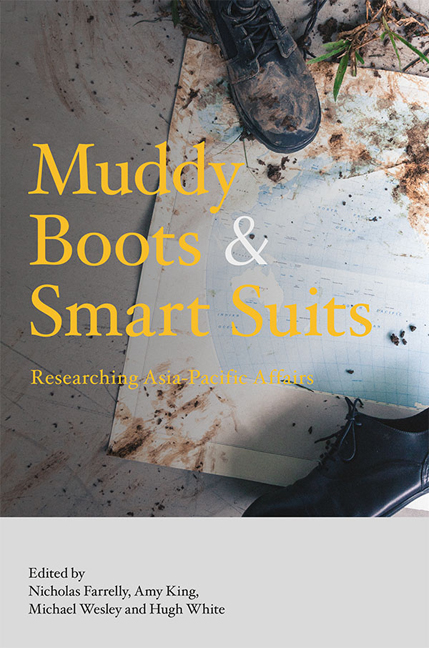Book contents
- Frontmatter
- Contents
- About the Contributors
- 1 Introduction to Research in Asia-Pacific Affairs
- Section I In the Field
- Section II Analysing Politics
- 5 The Design-based Revolution in Comparative Politics
- 6 Count Me In: Quantitative Research in Asia-Pacific Affairs
- Section III Shaping a Region
- Section IV Conflict and Order
- Section V Policy and Practice
- Bibliography
- Index
5 - The Design-based Revolution in Comparative Politics
from Section II - Analysing Politics
Published online by Cambridge University Press: 12 January 2018
- Frontmatter
- Contents
- About the Contributors
- 1 Introduction to Research in Asia-Pacific Affairs
- Section I In the Field
- Section II Analysing Politics
- 5 The Design-based Revolution in Comparative Politics
- 6 Count Me In: Quantitative Research in Asia-Pacific Affairs
- Section III Shaping a Region
- Section IV Conflict and Order
- Section V Policy and Practice
- Bibliography
- Index
Summary
INTRODUCTION
Is aerial bombardment an effective counter-insurgency tactic? Do immigrants depress local wages? Does the presence of natural resources harm democratic consolidation? Answering questions such as these requires the uncovering of general patterns of cause and effect. Social scientists have been attempting to put this search for causal inference on a sure philosophical and methodological footing at least since Émile Durkheim's pioneering research on suicide in the nineteenth century, but progress has been slow, coming in fits and starts. Even the diffusion of computing technology and the modelling revolution it brought about did not solve the problem. However, the last decade or so has seen one of the most exciting developments in the history of causal inference in the social sciences for generations.
The design-based revolution has transformed how social scientists go about their research and the kinds of causal inferences they can now draw from it. Field experiments and natural experiments are at the foundation of design-based inference. A growing body of scholarship outlining the principles, techniques, and promise of this kind of research already exists, but most of it has been aimed at an audience already well versed in comparative analysis and statistical methods (Gerber and Green 2012; Morgan and Winship 2015; Angrist and Pischke 2015; Imbens and Rubin 2015). The logic of design-based inference is actually very intuitive, despite its somewhat daunting technical language. In this chapter, I want to introduce the design-based approach to a non-specialist audience, primarily those who use qualitative rather than quantitative methods.
I first introduce the two main models of causal inference common to comparative politics, the sufficient-component-cause (SSC) model and the counterfactual model. Second, I outline the problem of confounding in traditional qualitative and quantitative methods in the social sciences. Third, I detail the experimental method in its basic form and present some examples of randomized controlled trials (RCTs) in Asia. Fourth, I discuss extensions to the experimental model in the form of natural experiments and again illustrate the method with some examples from Asia. Finally, I discuss the limitations of the design-based revolution and what needs to be addressed going forward.
- Type
- Chapter
- Information
- Muddy Boots and Smart SuitsResearching Asia-Pacific Affairs, pp. 59 - 72Publisher: ISEAS–Yusof Ishak InstitutePrint publication year: 2017

